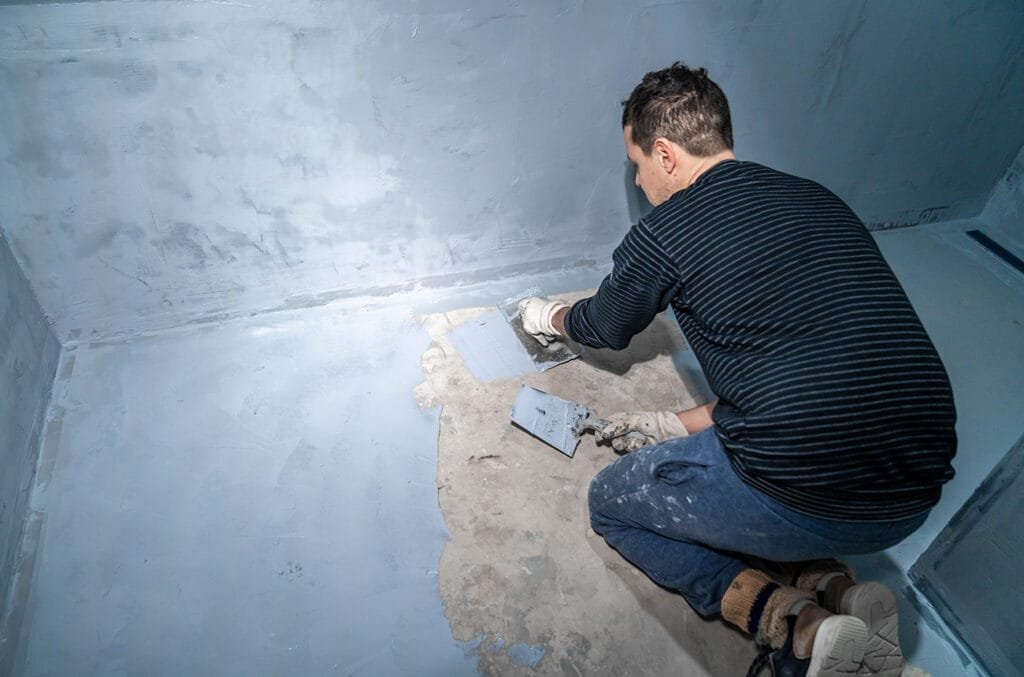
Basement Moisture Barriers & Vapor Control in Terre Haute, Indiana
A dry, comfortable basement starts with controlling vapor drive and liquid water before you think about framing or drywall. In West-Central Indiana, concrete slabs and foundation walls can hold moisture long after rain or snowmelt. The right barriers, perm ratings, and seam details stop damp smells, mold, and finish failures. They set you up for a long-lasting renovation.
TL;DR
- Fix exterior water first (gutters, downspouts, grading, sump discharge)
- Use continuous rigid foam on walls and a capillary break at the slab
- Tape/seal seams, insulate the rim joist, avoid double vapor barriers
- Add a dehumidifier in summer to hold around 50% RH
A dry, comfortable basement in West-Central Indiana starts by controlling how moisture moves, bulk leaks, capillary wicking, and vapor diffusion before you frame or drywall. Local humidity swings, clay soils, and freeze-thaw cycles make moisture management essential. The goal isn’t to make concrete “waterproof,” but to block wicking, slow vapor, and stabilize indoor RH so finishes stay sound year-round.
How Moisture Actually Moves
Concrete is porous, so moisture gets into basements by more than one route. To keep finishes dry and stable, you need to address each path with the right control layer.
- Bulk water (leaks): liquid water through cracks, gaps, or at the cove joint after storms
- Capillary action (wicking): moisture pulled through concrete pores into wood and finishes
- Vapor diffusion: invisible vapor migrating from high to low vapor pressure through concrete
- Air transport/condensation: humid indoor air reaching cool concrete and condensing
What stops each path:
- Capillary break under plates and floors interrupts wicking from slab to wood
- Vapor retarder (and continuous rigid foam) slows diffusion so humidity can’t build behind drywall
- Air barrier (taped foam, sealed seams, rim-joist insulation) blocks humid air from cold surfaces
- Drainage fixes (gutters, grading, French drain, sump) handle bulk water before it hits finishes
Takeaway: pair drainage with a continuous, sealed foam layer and proper capillary breaks so the assembly controls all four paths, not just one.
Choosing the Right Barrier Strategy
In most finished basements around Terre Haute, the wall system starts with continuous rigid foam. Taped and sealed seams create a true air barrier and a modest vapor retarder while adding R-value so the interior surface stays warmer and less prone to condensation. At the rim joist, use closed-cell spray foam or carefully fitted foam board with sealant; this is one of the coldest spots in the house and a common condensation source.
For floors, add a capillary break before finishes. A polyethylene layer under sleepers or a panelized subfloor lifts flooring off the slab, reducing that cool, clammy feel and protecting LVP or carpet from seasonal vapor. If you see efflorescence or damp tide lines along the bottom of walls, install a dimpled membrane that creates a drainage and ventilation space, then add rigid foam and your finish layers.
Quick checks:
- Walls need continuous rigid foam with taped seams to serve as air/vapor control and insulation
- Rim joists get closed-cell foam or sealed foam board to stop summer condensation
- Floors get a capillary break via poly under sleepers or an integrated subfloor system
- Visible damp lines call for a dimpled membrane tied to a drain path before foam and finishes
Where Each Layer Belongs
Think of a finished basement as a sequence of control layers that each do one job that block water, slow vapor, add insulation, and support finishes. Getting the order right keeps everything dry and durable.
Wall assembly order:
Concrete → dimple mat or waterproof coating (if needed) → rigid foam (taped at seams) → framing or furring → drywall or wall finish
Floor assembly order:
Concrete slab → polyethylene sheet or integrated subfloor panels → underlayment (if required) → finished flooring
Transitions matter. Seal foam edges at the slab and rim, tape all joints, and connect wall and floor barriers so the system works as one continuous air and vapor control layer.
This continuity keeps humidity out of framing, stabilizes surface temperatures, and prevents that musty basement smell before it starts.
Four Costly Mistakes To Avoid
- Ignoring the rim joist
It’s the coldest spot and a condensation magnet in summer. Insulate and air-seal with closed-cell spray foam or carefully fitted foam board plus sealant. - Sandwiching a wall between two low-perm layers
Traps moisture where it can’t dry. Pick one primary interior vapor retarder (usually taped rigid foam) and let the assembly dry in one direction. - Leaving foam seams, corners, and penetrations unsealed
Air leaks defeat vapor control. Tape all seams, seal edges to slabs and top plates, and caulk around pipes, wires, and boxes with compatible products. - Skipping a capillary break under treated bottom plates and sill areas
Wood will wick moisture from concrete. Add foam sill gasket or peel-and-stick membrane under plates and run a bead of sealant at the edges.
Do You Need Drainage Or Just Barriers?
If water shows up after storms, finishes can’t solve it. Address gutters, downspouts, grading, and footing drains first. Interior French drains and a reliable sump pump with a check valve and alarm are the right move for persistent seepage.
If you only struggle with musty odors or high humidity but no standing water, a solid barrier and insulation plan, paired with a right-sized dehumidifier will usually keep moisture under control without the need for major drainage work.
Dehumidifiers Still Matter
Even with good barriers, summer air in Vigo County can raise indoor humidity. A dehumidifier keeps relative humidity near 50% and protects finishes from condensation.
Choose a unit sized for the total square footage and typical humidity load. Connect it to a continuous drain line or sump to avoid manual emptying. Keep air paths clear so the unit can circulate air freely, and consider a ductable or whole-basement model if you’re finishing multiple rooms or want quieter operation.
Local Considerations In West-Central Indiana
Clay-heavy soils around Terre Haute hold water near foundations, and freeze–thaw cycles stress coatings and widen hairline cracks. Managing exterior water, clean gutters, extended downspouts, positive grading, and clear sump discharge reduces the load on interior systems and prolongs finish life.
Indoors, continuous rigid foam with taped seams stabilizes surface temperatures so corners stay dry, paint adheres, and flooring remains flat through seasonal humidity swings. Seal the rim joist, add a capillary break under plates, and maintain a dehumidifier target near 50% RH for a consistent, comfortable space year-round.
Quick Selection Guide
- Mostly odor and a cool slab, no visible water → poly under sleepers or an integrated subfloor, plus a dehumidifier
- Damp lines or blistered paint low on walls → dimple membrane to a drain path, then rigid foam with sealed seams
- Cold rim and summer condensation near band joists → closed-cell spray foam or sealed foam board at the rim
- Tight budget, planning to finish later → prioritize rim-joist insulation, capillary breaks, and drainage checks
How This Fits Your Finish Plan
Moisture control comes before framing layouts, lighting, and ceiling decisions. Once your control layers are set, you’ll know where to fasten studs, where to leave service cavities, and how to route dehumidifier drains. For the full roadmap, tie this into your main guide: Basement Remodeling & Finishing in Terre Haute.
Frequently Asked Questions On Basement Moisture Barriers
How do I know if I need drainage or just a moisture barrier?
If you see standing water or wet lines along the wall after storms, you’ll need drainage first, usually a sump pump or interior French drain. If it’s just humidity or light dampness, barriers and a dehumidifier are enough.
What’s the right perm rating for basement walls?
Aim for a Class II or “smart” vapor retarder (1–10 perms). This controls vapor flow without trapping moisture behind finishes.
Do I still need a dehumidifier if I install barriers?
Yes, in most Indiana basements. Barriers stop moisture entering from concrete, but ambient humidity still rises in summer. Keep relative humidity near 50 percent for comfort and mold prevention.
Can I finish a basement with only painted concrete walls?
Paint alone isn’t a moisture barrier. Over time, vapor will still pass through. Add rigid foam with taped seams before framing to control vapor and temperature.
Should I use a vapor barrier on both sides of a wall?
No. Two low-perm layers can trap moisture. Use one primary vapor control layer, usually the rigid foam and let the wall dry inward.

Need further assistance?
Unsure about something? Get in touch with us for a personalized consultation.
Ready to Dry-In Your Basement the Right Way?
Book a free in-home evaluation in Terre Haute and West-Central Indiana. We’ll verify moisture sources, map the right barrier and insulation layers, and give you a clear scope, timeline, and budget before you commit.
Serving Terre Haute, Clinton, Rockville, and surrounding areas.